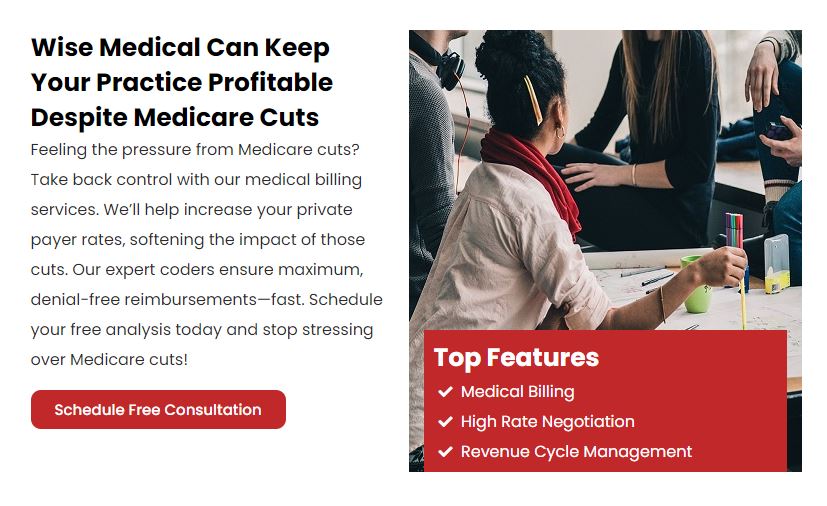Introduction
The process involves all billing steps and guidelines used to submit successful claims for provided services. DME is the use of equipment that healthcare providers provide patients for their improved mobility. It covers a variety of suppliers and devices that assist patients in their mobility and improve their lives with repetitive use at home. Common examples of such equipment are mobility devices, respiratory equipment, and diabetic supplies, which help patients improve their health with constant care at home. All this equipment has expensive costs, so accurate DME billing benefits patients and healthcare stakeholders equally.
Improved healthcare and accurate billing processes reduce patient co-pays and detectors, allowing providers to achieve maximum financial stability. Coding errors or lower compliance with claiming for DME have high risks of delayed or lower reimbursement rates. An improved billing process like Wise Medical Billing saves from claim rejection and provides rich opportunities to enhance healthcare practices’ financial performance and annual cash flow. This guide explains the DME billing process and its expected challenges in detail.
Step-By-Step DME Billing Process
Patient Intake and Insurance Verification
This step involves gathering patient information before providing the equipment and verifying the insurance plans. Providers gather patient demographics and perform a detailed insurance plan review at this stage. Advance verification with prior-authorization ensures that providing DME is covered under insurance and confirms the co-pay percentage for patients.
Prescription and Documentation
Maintaining foolproof documents is essential to prevent claim errors during DME billing. A valid prescription from the provider’s side, a detailed medical history of the patient to prove equipment necessity, and documents about the continuous need for the mentioned DME are compulsory records to use in the billing process. Missing any document from these can result in claim denials or delayed payments.
Prior Authorization
Many expensive DMEs need prior authorization from insurance providers to ensure their coverage under the plan. The healthcare providers analyze insurance plans to confirm the items that require PA according to the payer’s policy. After confirmation, the next step is to submit the PA form with supportive documents and await approval before delivering DME.
Equipment Delivery and Proof of Delivery
After receiving prior authorization approval, the patient receives the equipment. At this stage, providers must get proof of delivery for successful reimbursement. The equipment providers should deliver the mentioned items according to insurance policy guidelines and take the patient’s signature on the POD form to prove successful delivery. Maintaining accurate delivery records ensures successful claim submission and hassle-free audits for DME Providers.
Claim Submission and Processing
After gathering all the information and preparing the documents, the submission process starts. It involves accurate form filling using relevant billing codes and modifiers that clearly explain the rendered services in billing terms. Billing teams should double-check all information and attached documents to prevent mistakes in advance. Then, submission at the payer’s official website or through EHR software helps faster approval than manual submission.
Follow-Up and Appeals
If the applicant receives a claim denial or the application stays unpaid, this step must be performed. Active follow-up and appeal help to clear the objection and recover the underpaid reimbursements. For this step, DME providers should identify the reason behind the denial, which could be missing documents, incomplete information, or incorrect coding. After resolving the root cause, the applicant should resubmit the claim within the due date. Continuous monitoring and follow-up are also necessary to attend to ageing claims.
Key Guidelines for DME Billing
Compliance with Regulations
Successful reimbursement for DME is possible with a thorough understanding of the involved authorities’ requirements and maximum compliance with all of them. Medicare, Medicaid, and private insurance providers are the rule setter for this billing category. A billing team should follow their guidelines to prevent legal penalties and audit complexities. They follow the updated LCDs and NCDs requirements and maintain patients’ records responsibly to complete the billing documentation accurately. They must train the administrative staff for updated ICD-10 and HCPCS codes, helping to prevent coding errors.
Accurate Coding Practices
The payment process can speed up by ensuring that all clinical information and patient records are mentioned in billing claims without manual error. Since regulatory requirements and coding systems continuously face changes, billing staff should have current knowledge about HCPCS and ICD-10 codes so that coding errors cannot become a barrier in claim approval. The use of correct modifiers is also essential to reduce denial cases. Practices should regularly audit the claim process to rectify the coding mistakes according to the latest updates before facing financial issues.
Advance Beneficiary Notice (ABN)
Patients and service providers can accurately save themselves from unexpected financial liabilities using an ABN. This form clarifies that DME is compulsory for patients’ health improvement, and payers can negotiate with insurance providers about non-covered services. Service providers should explain to patients that their use of DME items is not covered by insurance and what financial responsibilities they have to attend to. This advanced discussion prevents billing disputes and allows practices to attend to their legal complexities. DME providers should get a patient’s sign on the ABN form to ensure they used non-covered items with their consent.
Common Challenges and Solutions
Complex Coding Requirements
DME covers a wide range of suppliers and devices, and knowing all relevant codes is challenging for practice administration. All coding series receive frequent updates, and using outdated codes can cause billing mistakes. Errors in coding or modifiers can stop the compensation payment and cause revenue leakage. Preference for automatic code suggestions over manual implementation according to billing scenarios can reduce errors.
Frequent Regulatory Changes
Insurance policies change frequently, and all private and government providers update them according to changes in service prices and sector demand. Changed coverage criteria and reimbursement rates can impact a patient’s financial responsibility; therefore, billing staff must update their knowledge according to the rules. Current knowledge helps to improve the compliance rate and prevent audit penalties. The DME professionals can connect with an authentic platform to receive regulatory updates immediately.
Documentation Accuracy
Accurate documentation represents service transparency and boosts the approval process; therefore, it must be completed without administrative mistakes. Incorrect and missing documents can cause revenue leakage and impact the patient’s satisfaction. DME service providers should verify the documents’ completeness before submitting the claims. This helps confirm the medical necessity and impact of provided equipment on a patient’s health. Practices should maintain all records, including PODs, ABNs, and PA approvals. Successfully maintaining these documents can reduce billing mistakes and maximize the reimbursement process.
Best Practices for Efficient DME Billing
Use of Technology
The manual submission process takes time and is highly risky; conversely, specialized DME billing software can facilitate the entire process. Automated coding and verification of accuracy through technology-based tools can reduce the chances of error. Practices should prefer AI-driven monitoring processes to analyze the latest trends and follow up on submitted claims.
Staff Training
Billing codes and regulatory requirements are not one-time settings but evolve according to the situation. Ongoing staff training is a compulsory part of optimization; practices should arrange frequent workshops and training sessions for their administration to update the knowledge according to the latest requirements. Mock internal audits also help identify areas for improvement and keep the billing process on track.
Regular Internal Audits
DME service providers should frequently perform internal audits to identify data breaches or billing mistakes. It helps to adopt proactive measures for error rectification and saves from legal penalties. Practices should set a monthly or quarterly schedule to analyze the billing system. They must use billing software for complex cases and reduce inconsistent data patterns. A wise corrective action plan can help to rectify the issues without facing regulatory fines.
Clear Communication
All billing stakeholders should maintain cooperative communication, which helps clarify ongoing misunderstandings and prevent billing disputes. Service providers should educate patients about their financial responsibilities and expected co-pays and take their sign-on ABN for non-covered services. The practices should develop direct links with payers to comprehensively understand their requirements and coverage policies. A healthy collaboration between all involved billing parties increases the compliance ratio and reduces surprised billing.
Final Analysis
DME billing is a complex process that demands comprehensive knowledge about regulations and rules set by insurance payers. Accurate coding knowledge and document management are necessary to prevent later hassle regarding denials and delayed payments. Practices should adopt all precautionary measures and current billing strategies to avoid administrative burden for reclaiming. Claim denial or ageing claims can cause financial loss and affect the annual revenue of DME providers; ongoing optimization of the submission process works as a proactive strategy to ensure successful approval. The billing teams should ensure that implemented codes are accurate according to utilized items and must continually follow up to check the claim status. It helps to remove the expected error in claims regarding documents or coding accuracy.

